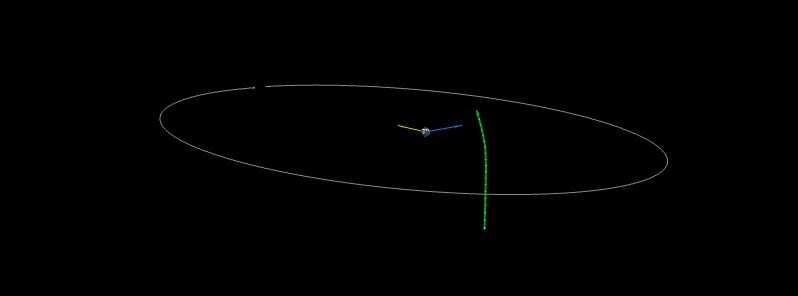Asteroid 2017 SR2 to flyby Earth at 0.24 LD on September 20, second of the day

A newly discovered asteroid designated 2017 SR2 will flyby Earth at a very close distance of 0.24 LD (~92 160 km / 57 265 miles) at 20:29 UTC on September 20, 2017. This is the second known near-Earth asteroid to flyby Earth at a distance of 1 LD today, the third within the past 7 days and the 31st since the start of the year.
Asteroid 2017 SR2 was discovered at Catalina Sky Survey on September 20, 2017, some 12 hours before its expected flyby. It belongs to the Apollo group of asteroids and has an estimated diameter between 5.1 and 11 m (16 and 36 feet).
It will flyby Earth at 20:29 UTC (± 1 minute) at a speed (relative to the Earth) of 9.99 km/s.
[ Ephemeris | Orbit Diagram | Orbital Elements | Physical Parameters | Close-Approach Data ]
This is the 31st known near-Earth asteroid to flyby Earth within 1 LD since the start of the year, the second (after 2017 SM2) today and the third (after 2017 SQ2 and 2017 SM2) within the past 7 days, according to data available at CNEOS on September 20, 2017. You can find them in our Near-Earth Objects category. It might also be interesting to compare what you find there with our reports of all notable bright fireballs around the globe. You can find that in our Meteor Activity category.
The closest one (2017 GM) flew past Earth at just 0.04 LD (~15 360 / 9 544 miles) on April 4. Its estimated diameter is between 2.8 and 6.3 m (9 and 20 feet).
The largest so far was 2017 QP1 with an estimated diameter of 37 to 83 m (121 to 272 feet). It flew past Earth at 0.16 LD (~61 440 km / 38 177 miles) on August 14.
As of September 16, there are 16 675 known near-Earth objects. Of them, 16 569 are near-Earth asteroids. Of the total number of known near-Earth object, we have discovered 1 163 since the start of the year. All of them are asteroids. In 2016, we discovered a total of 1 889 near-Earth objects; 1 comet and 1 888 near-Earth asteroids.
Of the total number (16 569) of near-Earth asteroids discovered by September 16, 2017, 9 006 belong to the Apollo group of asteroids, same as today's 2017 SM2 and SR2. 6 327 belong to the Amor group, 1 220 to Aten group and 16 to Atira group. 157 are Potentially Hazardous Asteroids with diameters roughly 1 km (0.62 miles) and larger. 881 of the total number have diameters roughly 140 m (460 feet) and larger.
For comparison, asteroid that exploded some 29.7 km (18.5 miles) above Russian city of Chelyabinsk at 09:20 YEKT (03:20 UTC) on February 15, 2013, damaging over 3 000 buildings and injuring over 1 500 people (mostly by broken window glass), had an estimated size of approximately 20 m (65 feet). Its light was brighter than the Sun, visible up to 100 km (62 miles) away.
Chelyabinsk asteroid, officially named Chelyabinsk meteorite, was undetected before its atmospheric entry, in part because its radiant was close to the Sun.

Check your speakers. Loud asteroid explosion on video.
In the hours following the visual meteor sighting, a 6-metre (20 feet) wide hole was discovered on Lake Chebarkul's frozen surface and scientists from the Ural Federal University collected 53 samples from around the hole the same day it was discovered.
A large number of small meteorites fell on areas west of Chelyabinsk and local residents and schoolchildren located and picked up some of them, many located in snowdrifts, by following a visible hole that had been left in the outer surface of the snow.


In June 2013, Russian scientists reported that further investigation by magnetic imaging below the location of the ice hole in Lake Chebarkul had identified a 60 cm (2 feet) wide meteorite buried in the mud at the bottom of the lake. Following an operation lasting a number of weeks, it was raised from the bottom on October 16, 2013. With a total mass of 654 kg (1 442 lb), this is the largest found fragment of the Chelyabinsk meteorite.
In November 2013, a video from a security camera was released showing the impact of the fragment at the Chebarkul Lake. From the measured time difference between the shadow generating meteor to the moment of impact, scientists calculated that this meteorite hit the ice at about 225 meters per second, 64 percent of the speed of sound.
This is the first recorded impact of a meteorite on video. You can see it below:


Video shows the first recorded impact of a meteorite. Chelyabinsk, Russia February 15, 2017
Reference:
Asteroid 2017 SR2 at Minor Planet Center; at CNEOS
Featured image: The green line indicates the object's apparent motion relative to the Earth, and the bright green marks are the object's location at approximately one-hour intervals. The Moon's orbit is gray. The blue arrow points in the direction of Earth's motion and the yellow arrow points toward the Sun. Credit: Minor Planet Center

Commenting rules and guidelines
We value the thoughts and opinions of our readers and welcome healthy discussions on our website. In order to maintain a respectful and positive community, we ask that all commenters follow these rules.